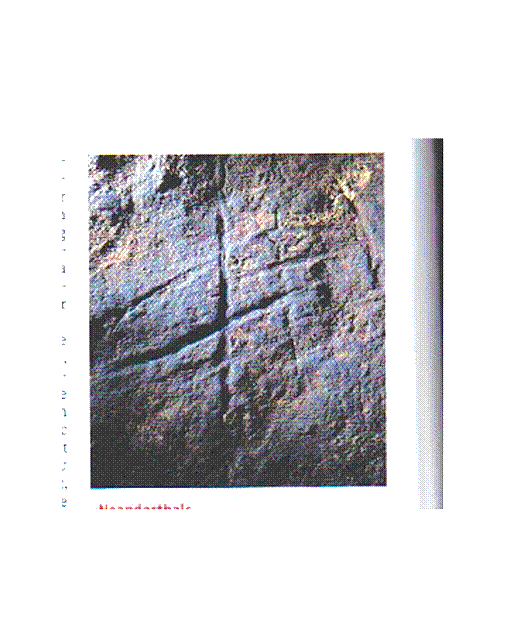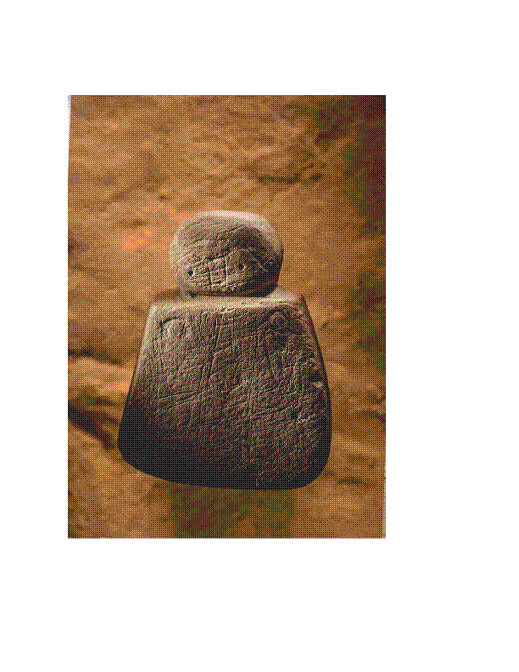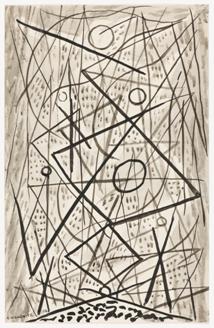Linear images off topic:
Things in the news seem so grim nowadays that I’m going to take a break and just have some fun. They found some images on a cave wall in Gibraltar.

(Lowbrow Art ECONOMIST vol. 412 no. 8902 September 6, 2014 page 82) I blew the illustration up a bit and brightened it and increased the contrast so you can see it. The color and the grain that looks like burlap are an artifact of the printing process. It’s the lines that are the interesting part. They recon it is from 39 thousand years ago. That was before modern humans got to that part of the world and the suggestion is that the work was by a Neanderthal. No scale is offered, but the suggestion is that it took three hundred careful strokes with a cutting rock to do it. At five seconds per stroke that would be almost a half hour of Neanderthal time. You do wonder how good the light was. The image I lifted gives a pretty good impression for the inside of a cave.
So compare this:

(Roff Smith, photograph Jim Richardson Before Stonehenge NATIONAL GEOGROPHIC vol. 226 no. 2 August 2014 page 26)
It’s from the Stones of Stennis in the Orkney Islands about 3200 BC. This time they are kind enough to give us a notion of scale; she is about the size of a domino.
Looks kind of modern, doesn’t she? Look at this:

https://www.google.com/search?q=modern+art+images&rlz=1C2GGGE_enUS372&biw=1164&bih=650&tbm=isch&imgil=3kfzPZUtWQHgVM%253A%253BDnhPqaARyKUoZM%253Bhttp%25253A%25252F%25252Fdesktopbackgroundshq.com%25252Fabstract-backgrounds%25252Fmodern-art&source=iu&fir=3kfzPZUtWQHgVM%253A%252CDnhPqaARyKUoZM%252C_&usg=__itDPadaj8E8y6DAE2cjYZJp5Rck%3D&sa=X&ei=yHwMVNGpLvLgsATOmoLIBw&sqi=2&ved=0CCAQ9QEwAA#facrc=_&imgdii=_&imgrc=ybVzXvabRVQIJM%253A%3BcKdD0Lj3phcslM%3Bhttp%253A%252F%252Fwww.kiarts.org%252Fimages%252Fcollection%252Ffor_and_against_modern_art_the_armory_show_walkowitz.jpg%3Bhttp%253A%252F%252Fwww.kiarts.org%252Fpage.php%253Fpage_id%253D660%3B668%3B1024 downloaded September 7, 2014
Now there is an address worthy of the name. The notion of a cultural survival over so many millennia seems hard to credit. We’d know about it if it were true.
Another possibility is that at least for the ancient work scratching a straight line was the easiest way to make a bold mark. Of course the modern artist could have done anything, and with a little effort you might be able to find a modern work even closer to the ancient ones.
The trouble with the “easiest way” explanation is that for me at least the three directions easiest to draw are vertical, horizontal and high-right to low-left. But the diagonals go low-right to high left. Were both artists southpaws?
Another possibility is that lines were drawn because that is the way the neurophysiology of sight works. This was studied by Hubel and Wiesel at Harvard in the 1960’s. They were brilliant scientists and engaged, enthusiastic teachers. I remember them well. According to their discoveries a scene is interpreted first as the intensity pattern of incoming light, then as the contrast between a point and its surround, then as lines and then progressively more abstract patterns. So seeing lines is to vision as hearing tones is to listening to music. Actually at that time, and so far as I know ever since, the same sequential abstractions that give us vision have not been sorted out in hearing to the same degree.
While we are on Neanderthal vision, you know that the human visual system processes frames at a finite rate. The apparent smooth motion of movies and TV happens because it is technically possible to present images faster than the human eye can process. A dog processes vision faster. For a dog humans move in slow motion and a movie is just a flashing randomly patterned light.
Somebody once claimed that an ancient depiction of a running horse showed the legs in their proper position. This wasn’t possible for us moderns until high speed photography. Our natural vision just can’t interpret fast enough to interpret a horse moving at speed.
As I said, this was just for fun. We’ll get back to gloom and doom soon.
There have been 86 visitors over the past month.
Home page.


